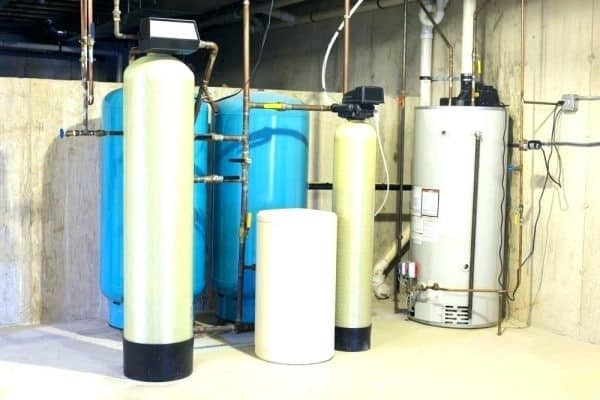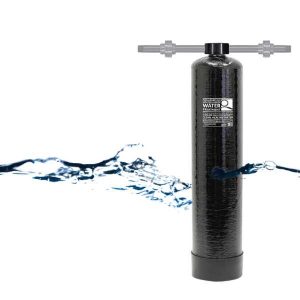7 Tips On How To Maintain Your Water Softener
1) Don’t Let Salt Bridges or Salt Mushes Form
Salt bridges are hard crusts that accumulate along with the brine tank. As more salt is used, salt deposits itself on the sides of the tank and forms salt bridges. At one point, a salt bridge forms a thick layer that separates water entering the system from the salt solution.
A salt bridge, therefore, hinders a salt water softener from performing effectively.
Salt mushes are a much more serious problem compared to salt bridges. When a lot of salt accumulates, it continues to recrystallize itself. This leads to a thick layer of mush that gathers at the bottom of the tank. This, in turn, reduces the efficiency of the regeneration cycle.
Keep a check on any salt bridge or salt mushes forming in your tank. The use of good quality salt is a preventative measure to stop salt sludges and layers from forming.
On the off-chance you still see some salt mushing or a thick sludge, you can knock it off with the back of a broomstick!
2) Use Good Quality of Salt
High-quality salt guarantees an increased lifespan of your water softener. Your best options are to choose from rock salt, solar salt and evaporated salt.
Rock salt is widely available but contains many impurities that can accumulate in a brine tank to form thick sludges.
Solar salt is made from evaporated sea salt and is also a viable option since they have a higher solubility than rock salt.
However, your preferred option is to use evaporated salt pellets. They have a higher solubility and no impurities, which don’t affect the brine tank.

3) Clean The Brine Tank Regularly
The best time to clean the brine tank is when it’s almost empty so that you can see any dirt or impurities at the bottom of the tank.
Firstly you need to turn the water softener system off by locating the bypass valve, after which you can start cleaning the brine tank.
During cleaning, make sure there’s a space where you can drain water and get rid of the excess brine solution. Following the instructions manual, you can disassemble the brine tank components and cleanse and wash the tank properly to get rid of the dirty salt.
The components can be cleaned by mixing dishwashing detergent with water to create a cleaning solution. Make sure you let the tank dry before you reassemble it after which you can fill in the salt for the brine tank.
After you’ve reassembled the components, you can switch the water softener system on by activating the bypass valve again.
4) Clean The Resin Tank
Your water softener consists of resin beads on a large resin bed. The manual regeneration cycle removes the buildup from the resin beads, but they still need their upkeep.
Resin tanks need refilling every two months anyway, so knowing how to clean them is a beneficial skill. Resin tanks can be cleaned manually or with the help of an iron solution resin cleaner.
After making sure the water softener’s unplugged and disconnecting the control valve, you can manually clean the resin beads on the resin bed. You can also use an iron remover solution to cleanse the resin bed as well.
To maximize resin life, it’s necessary to maintain resin beads by using resin cleaners or washing them manually.
5) Clean The Venturi Valve Regularly
To transport the brine solution into the resin tank during the regeneration cycle, the venturi valve creates the suction for water softener systems to be able to do so.
The venturi valve can get blocked by a layer of sediment because it frequently comes in contact with the brine solution. This can stop the water softener from working properly.
To keep up with the water softener maintenance, examine the valve for any blockage. If you happen to find blockages, you can clean the venturi valve by unscrewing the cover and removing the parts inside. Cleansing can be done with any soap and water solution.
Venturi valves need to be maintained at least twice annually, but if you want to, you can cleanse them every month too!
6) Keep A Check On The Salt
Salt-based water softeners work through salt. Brine tanks need regular salt refills every two months for water softeners to perform the ion exchange process. But it’s better if you keep an eye on the salt system more often!
Keep a check on the brine tank now and then to make sure the salt is completely wet and covered in water. If not, that means it’s time to fill the brine tank with salt!
It’s even more important to keep your checks consistent if your water softener system is older than 10 years!
This tip is important to check off your water softener maintenance checklist.
7) Keep A Professional At Hand
For most of a water softener’s life, you shouldn’t need a professional’s help regarding water softener maintenance.
If a problem persists even though you’ve cleaned the brine tank and resin bed, taken care of salt refills, and prevented salt mushing, then it’s time to call for a professional!
Professionals have a deeper extensive knowledge that may be useful for your safety and avoid any plumbing disasters!
Conclusion
When it’s time for your water softener’s annual or regular maintenance, you can go through these tips to ensure the maximum lifespan of your water treatment systems!
